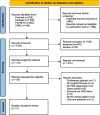Clinical prediction models for the early diagnosis of obstructive sleep apnea in stroke patients: a systematic review
- PMID: 38268059
- PMCID: PMC10807185
- DOI: 10.1186/s13643-024-02449-9
Clinical prediction models for the early diagnosis of obstructive sleep apnea in stroke patients: a systematic review
Abstract
Background: Obstructive sleep apnea (OSA) is a common sleep disorder characterized by repetitive cessation or reduction in airflow during sleep. Stroke patients have a higher risk of OSA, which can worsen their cognitive and functional disabilities, prolong their hospitalization, and increase their mortality rates.
Methods: We conducted a comprehensive literature search in the databases of PubMed, CINAHL, Embase, PsycINFO, Cochrane Library, and CNKI, using a combination of keywords and MeSH words in both English and Chinese. Studies published up to March 1, 2022, which reported the development and/or validation of clinical prediction models for OSA diagnosis in stroke patients.
Results: We identified 11 studies that met our inclusion criteria. Most of the studies used logistic regression models and machine learning approaches to predict the incidence of OSA in stroke patients. The most frequently selected predictors included body mass index, sex, neck circumference, snoring, and blood pressure. However, the predictive performance of these models ranged from poor to moderate, with the area under the receiver operating characteristic curve varying from 0.55 to 0.82. All the studies have a high overall risk of bias, mainly due to the small sample size and lack of external validation.
Conclusion: Although clinical prediction models have shown the potential for diagnosing OSA in stroke patients, their limited accuracy and high risk of bias restrict their implications. Future studies should focus on developing advanced algorithms that incorporate more predictors from larger and representative samples and externally validating their performance to enhance their clinical applicability and accuracy.
Keywords: Obstructive sleep apnea; Prediction models; Stroke; Systematic review.
© 2024. The Author(s).
Conflict of interest statement
The authors declare that they have no competing interests.
Similar articles
-
Educational, supportive and behavioural interventions to improve usage of continuous positive airway pressure machines in adults with obstructive sleep apnoea.Cochrane Database Syst Rev. 2014 Jan 8;(1):CD007736. doi: 10.1002/14651858.CD007736.pub2. Cochrane Database Syst Rev. 2014. Update in: Cochrane Database Syst Rev. 2020 Apr 7;4:CD007736. doi: 10.1002/14651858.CD007736.pub3. PMID: 24399660 Updated.
-
Effects of opioid, hypnotic and sedating medications on sleep-disordered breathing in adults with obstructive sleep apnoea.Cochrane Database Syst Rev. 2015 Jul 14;(7):CD011090. doi: 10.1002/14651858.CD011090.pub2. Cochrane Database Syst Rev. 2015. PMID: 26171909
-
Regional cerebral blood flow single photon emission computed tomography for detection of Frontotemporal dementia in people with suspected dementia.Cochrane Database Syst Rev. 2015 Jun 23;2015(6):CD010896. doi: 10.1002/14651858.CD010896.pub2. Cochrane Database Syst Rev. 2015. PMID: 26102272 Free PMC article.
-
The Role of Novel Digital Clinical Tools in the Screening or Diagnosis of Obstructive Sleep Apnea: Systematic Review.J Med Internet Res. 2023 Jul 26;25:e47735. doi: 10.2196/47735. J Med Internet Res. 2023. PMID: 37494079 Free PMC article.
-
The comparative and added prognostic value of biomarkers to the Revised Cardiac Risk Index for preoperative prediction of major adverse cardiac events and all-cause mortality in patients who undergo noncardiac surgery.Cochrane Database Syst Rev. 2021 Dec 21;12(12):CD013139. doi: 10.1002/14651858.CD013139.pub2. Cochrane Database Syst Rev. 2021. PMID: 34931303 Free PMC article.
Cited by
-
A Risk Correlative Model for Sleep Disorders in Chinese Older Adults Based on Blood Micronutrient Levels: A Matched Case-Control Study.Nutrients. 2024 Sep 29;16(19):3306. doi: 10.3390/nu16193306. Nutrients. 2024. PMID: 39408273 Free PMC article.
-
Exploring the potential biomarkers between stroke and obstructive sleep apnea by WGCNA and machine learning.Sleep Breath. 2025 Jun 20;29(4):219. doi: 10.1007/s11325-025-03369-1. Sleep Breath. 2025. PMID: 40540134
-
OSApredictor: A tool for prediction of moderate to severe obstructive sleep apnea-hypopnea using readily available patient characteristics.Comput Biol Med. 2024 Aug;178:108777. doi: 10.1016/j.compbiomed.2024.108777. Epub 2024 Jun 19. Comput Biol Med. 2024. PMID: 38901189 Free PMC article.
-
Artificial intelligence in respiratory care.Front Digit Health. 2024 Dec 23;6:1502434. doi: 10.3389/fdgth.2024.1502434. eCollection 2024. Front Digit Health. 2024. PMID: 39764208 Free PMC article. Review.
-
Artificial Intelligence in Sleep Medicine: The Dawn of a New Era.Nat Sci Sleep. 2024 Apr 30;16:445-450. doi: 10.2147/NSS.S474510. eCollection 2024. Nat Sci Sleep. 2024. PMID: 38711863 Free PMC article. No abstract available.
References
-
- Brown DL, Gibbs R, Shi X, Case E, Chervin R, Lisabeth LD. Growing prevalence of post-stroke sleep-disordered breathing. Stroke. 2021;52(SUPPL 1):AP597.
Publication types
MeSH terms
LinkOut - more resources
Full Text Sources
Miscellaneous


